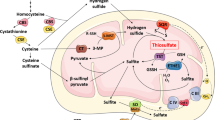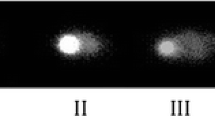Abstract
Guanidinoacetate methyltransferase deficiency (GAMT deficiency) is an inherited neurometabolic disorder clinically characterized by epilepsy and mental retardation and biochemically by accumulation of guanidinoacetate (GAA) and depletion of creatine. Although this disease is predominantly characterized by severe neurological findings, the underlying mechanisms of brain injury are not yet established. In the present study, we investigated the effect of intrastriatal administration of GAA on Na+, K+-ATPase activity, total (tCK), cytosolic (Cy-CK), and mitochondrial (Mi-CK) creatine kinase (CK) activities in rat striatum. We verified that Na+, K+-ATPase, tCK, and Mi-CK activities were significantly inhibited by GAA, in contrast to Cy-CK which was not affected by this guanidino compound. Since these enzyme activities can be affected by reactive species, we also investigated the effect of intrastriatal administration of GAA on thiobarbituric acid reactive substances (TBARS), an index of lipid peroxidation in rats. We found that this metabolite significantly increased this oxidative stress parameter. Considering the importance of Na+, K+-ATPase and CK activities for brain metabolism homeostasis, our results suggest that the inhibition of these enzymes by increased intracerebral levels of GAA may contribute to the neuropathology observed in patients with GAMT-deficiency.



Similar content being viewed by others
References
Aksenov M, Aksenova M, Butterfield DA, Markesbery WR (2000) Oxidative modification of creatine kinase BB in Alzheimer's disease brain. J Neurochem 74:2520–2527
Bessman SP, Carpenter CL (1985) The creatine-creatine phosphate energy shuttle. Annu Ver Biochem 54:831–865
Bradford MM (1976) A rapid and sensitive method for the quantitation of microgram quantities of protein utilizing the principle of protein-dye-binding. Anal Biochem 72:248–254
Braissant O, Henry H, Loup M, Eilers B, Bachmann C (2001) Endogenous synthesis and transport of creatine in the rat brain: An in situ hybridization study. Mol Brain Res 86:193–201
Chan KM, Delfer D, Junger KD (1986) A direct colorimetric assay for Ca2+-stimulated ATPase activity. Anal Biochem 157:375–380
Erecinska M, Silver IA (1994) Ions and energy in mammalian brain. Prog Neurobiol 43:37–71
Folbergrova J, Haugvicova R, Mares P (2001) Attenuation of seizures induced by homocysteic acid in immature rats by metabotropic glutamate group II and group III receptor agonosts. Brain Res 980:120–129
Grisar T (1984) Glial and neuronal Na+ K+ pump in epilepsy. Ann Neurol 16:128–134
Gross WL, Bak MI, Ingwall JS, Arstall MA, Smith TW, Balligand JL, Kelly RA (1996) Nitric oxide inhibits creatine kinase and regulates heart contractile reserve. Proc Natl Acad Sci USA 93:5604–5609
Hamman BL, Bittl JA, Jacobus WE, Allen PD, Spencer RS, Tian R, Ingwall JS (1995) Inhibition of the creatine kinase reaction decreases the contractile reserve of isolated rat hearts. Am J Physiol 269:1030–1036
Hiramatsu M, Ohba S, Edamatsu R, Kadowari D, Mori A (1992) Effect of guanidino compounds on membrane fluidity of rats synaptosomes. In: De Deyn PP, Marescau IA, Quereshi SD, Mori A (eds) Guanidino compounds in biology & medicine, vol 1. John Libbey & Company Ltd, Guildford, UK, pp 387–393
Hughes BP (1962) A method for the estimation of serum creatine kinase and its use in comparing creatine kinase and aldolase activity in normal and pathological sera. Clin Chim Acta 7:597–603
Jones DH, Matus AI (1974) Isolation of plasma synaptic membrane from brain by combination flotation-sedimentation density gradient centrifugation. Biochim Biophys Acta 356:276–287
Lees GJ (1993) Contributory mechanisms in the causation of neurodegenerative disorders. Neuroscience 54:287–322
Leipnitz G, Schuck PF, Ribeiro CA, Dalcin KB, Assis DR, Barschak AG, Pulrolnik V, Wannmacher CM, Wyse AT, Wajner MM (2003) Ethylmalonic acid inhibits mitochondrial creatine kinase activity from cerebral cortex of young rats in vitro. Neurochem Res 28:771–777
Leuzzi V, Bianchi MC, Tosetti M, Carducci C, Cerquiglini CA, Cioni G, Antonozzi I, (2000) Brain creatine depletion: Guanidinoacetate methyltransferase deficiency (improving with creatine supplementation). Neurology 14:1407–1409
Lowry OH, Rosebrough NJ, Farr AL, Randall RJ (1951) Protein measurement with the Folin phenol reagent. J Biol Chem 193:265–267
Matsumoto M, Kobayashi K, Kishikawa H, Mori A (1976) Convulsive activity of methylguanidine in cat and rabbits IRCS. Med Sci 4:65
Mori A, Kohno M, Masumizu T, Noda Y, Packer L (1996) Guanidino compounds generate reactive oxygen species. Biochem Mol Biol Int 40:135–143
Neu A, Neuhoff H, Trube G, Fehr S, Ullrich K, Roeper J, Isbrandt D (2002) Activation of GABAA receptors by guanidinoacetate: A novel pathophysiological mechanism. Neurobiol Dis 11:298–307
O'Gorman E, Beutner G, Wallimann T, Brdiczka D (1996) Differential effects of creatine depletion on the regulation of enzyme activities and on creatine-stimulated mitochondrial respiration in skeletal muscle, heart, and brain. Biochim Biophys Acta 1276:161–170
Ohkawa H, Ohishi N, Yagi K (1979) Assay for lipid peroxides in animal tissues by thiobarbituric acid reaction. Anal Biochem 95:351–358
Ramirez O, Jiménez E (2000) Opposite transitions of chick brain catalytically active cytosolic creatine kinase isoenzymes during development. Int J Dev Neurosci 18:815–823
Saks VA, Kuznetsov AV, Kupriyanov VV, Miceli MV, Jacobus WE (1985) Creatine kinase of rat heart mitochondria. The demonstration of functional coupling to oxidative phosphorylation in an inner membrane-matrix preparation. J Biol Chem 260:7757–7764
Schlegel J, Wyss M, Schurch U, Schnyder T, Quest A, Wegmann G, Eppenberger HM, Wallimann T (1988) Mitochondrial creatine kinase from cardiac muscle and brain are two distinct isoenzymes but both form octameric molecules. J Biol Chem 263:16963–16969
Schuck PF, Rosa RB, Pettenuzzo LF, Sitta A, Wannmacher CMD, Wyse ATS, Wajner M (2002) Inhibition of mitochondrial creatine kinase activity from rat cerebral cortex by methylmalonic acid. Neurochem Res 27:1633–1639
Schulze A, Ebinger F, Rating D, Mayaetepek E (2001) Improving treatment of guanidinoacetate methyltransferase deficiency: Reduction of guanidinoacetic acid in body fluids by arginine restriction and ornithine supplementation. Mol Genet Metab 74:413–419
Schreier S, Polnaze CF, Smith ICP (1978) Spin labels in membrane: Problem in practice. Biochem Biophys Acta 553:84–95
Shiraga H, Hiramatsu M, Mori A (1986) Convulsive activity of α-guanidino glutaric acid and the possible involvement of 5-hydroxytrytamine in the α-guanidino glutaric acid induced seizure mechanism. J Neurochem 47:1832–1836
Silva CG, Parolo E, Streck EL, Wajner M, Wannmacher MCD, Wyse ATS (1999) In vitro inhibition of Na+,K+-ATPase activity from cerebral cortex by guanidino compounds accumulating in hyperargininemia. Brain Res 838:78–84
Stöckler S, Hanefeld F, Frahm J (1996) Creatine replacement therapy in guanidinoacetate methyltransferase deficiency, a novel error of metabolism. Lancet 348:789–790
Tomimoto H, Yamamoto K, Homburger HA, Yanagihara T (1993) Immunoelectron microscopic investigation of creatine kinase BB-isoenzyme after cerebral ischemia in gerbils. Acta Neuropathol 86:447–455
Von Figura K, Hanefeld F, Isbrandt D, Stöckler-Ipsiroglu S (2001) Guanidinoacetate methyltransferase deficiency. In: Scriver CR, Beaudet AL, Sly WS, Valle D (eds) The metabolic and molecular bases of inherited disease, 8th edn. McGraw-Hill, New York, pp 1897–1908
Wallimann T, Wyss M, Brdiczka D, Nicolay K, Eppenberger HM (1992) Intracellular compartmentation, structure and function of creatine kinase isoenzymes in tissues with high and fluctuating energy demands: The ‘phosphocreatine circuit' for cellular energy homeostasis. Biochem J 281:21–40
Wolosker H, Panizzutti R, Englender S (1996) Inhibition of creatine kinase by S-nitrosoglutathione. FEBES Lett 392:274–276
Wyse ATS, Wajner M, Brusque A, Wannmacher CMD (1995) Alanine reverses the inhibitory effect of phenylalanine and its metabolites on Na+,K+-ATPase in synaptic plasma membranes from cerebral cortex of rats. Biochem Soc Trans 23:227S
Wyse ATS, Streck EL, Barros SVT, Brusque AM, Zugno AI, Wajner M (2000) Methylmalonate administration decreases Na+,K+-ATPase activity in cerebral cortex of rats. Neuroreport 11:2311–2315
Yousef MI, El Hendy HA, El-Demesdash FM, Elagamy EI (2002) Dietary zinc deficiency induced-changes in the activity of enzymes and the level of free radicals, lipids and protein electrophoretic behavior in growing rats. Toxicology 175:223–234
Yu SP (2003) Na+,K+ -ATPase: The new face of an old player in pathogenesis and apoptotic/hybrid cell death. Biochem Pharmacol 66:1601–1609
Zugno AI, Franzon R, Chiarani F, Bavaresco CS, Wannmacher CMD, Wajner M, Wyse ATS (2004) Evaluation of the mechanism underlying the inhibitory effect of guanidinoacetate on brain Na+,K+-ATPase activity. Int J Dev Neurosci 22:191–196
Zugno AI, Stefanello FM, Streck EL, Calcagnotto T, Wannmacher CMD, Wajner M, Wyse ATS (2003) Inhibition of Na+,K+-ATPase activity in rat striatum by guanidinoacetate. Int J Dev Neurosci 21:183–189
Acknowledgments
We would like to thank Renata Franzon for her technical assistance. This work was supported in part by grants from FAPERGS, RS-Brazil, PROPESQ/UFRGS, RS-Brazil, and CNPq, DF-Brazil.
Author information
Authors and Affiliations
Corresponding author
Rights and permissions
About this article
Cite this article
Zugno, A.I., Scherer, E.B.S., Schuck, P.F. et al. Intrastriatal Administration of Guanidinoacetate Inhibits Na+, K+-ATPase and Creatine Kinase Activities in Rat Striatum. Metab Brain Dis 21, 39–48 (2006). https://doi.org/10.1007/s11011-006-9003-8
Received:
Accepted:
Published:
Issue Date:
DOI: https://doi.org/10.1007/s11011-006-9003-8




